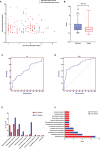The Clinical Value of Procalcitonin in the Neutropenic Period After Allogeneic Hematopoietic Stem Cell Transplantation
- PMID: 35547733
- PMCID: PMC9082027
- DOI: 10.3389/fimmu.2022.843067
The Clinical Value of Procalcitonin in the Neutropenic Period After Allogeneic Hematopoietic Stem Cell Transplantation
Abstract
The diagnostic value of procalcitonin and the prognostic role of PCT clearance remain unclear in neutropenic period after allogeneic hematopoietic stem cell transplantation introduction. This study evaluated 219 febrile neutropenic patients (116, retrospectively; 103, prospectively) who underwent allo-HSCT from April 2014 to March 2016. The area under the receiver operator characteristic curve (AUC) of PCT for detecting documented infection (DI) was 0.637, and that of bloodstream infection (BSI) was 0.811. In multivariate analysis, the inability to decrease PCT by more than 80% within 5-7 days after the onset of fever independently predicted poor 100-day survival following allo-HSCT (P = 0.036). Furthermore, the prognostic nomogram combining PCTc and clinical parameters showed a stable predictive performance, supported by the C-index of 0.808 and AUC of 0.813 in the primary cohort, and C-index of 0.691 and AUC of 0.697 in the validation cohort. This study demonstrated the diagnostic role of PCT in documented and bloodstream infection during the neutropenic period after allo-HSCT. PCTc might serve as a predictive indicator of post-HSCT 100-day mortality. A nomogram based on PCTc and several clinical factors effectively predicted the 100-day survival of febrile patients and may help physicians identify high-risk patients in the post-HSCT neutropenic period.
Keywords: allogeneic hematopoietic stem cell transplantation; infectious disease; nomogram; procalcitonin; prognosis.
Copyright © 2022 Shan, Shen, Song, Xu, Qiu, Chen, Han, Tang, Miao, Sun, Wu and Xu.
Conflict of interest statement
The authors declare that the research was conducted in the absence of any commercial or financial relationships that could be construed as a potential conflict of interest.
Figures




Similar articles
-
Diagnostic value of sepsis biomarkers in hematopoietic stem cell transplant recipients in a condition of high prevalence of gram-negative pathogens.Hematol Oncol Stem Cell Ther. 2017 Mar;10(1):15-21. doi: 10.1016/j.hemonc.2016.09.002. Epub 2016 Oct 20. Hematol Oncol Stem Cell Ther. 2017. PMID: 27793578
-
Risk factor for death in hematopoietic stem cell transplantation: are biomarkers useful to foresee the prognosis in this population of patients?Infection. 2014 Dec;42(6):1023-32. doi: 10.1007/s15010-014-0685-2. Epub 2014 Sep 30. Infection. 2014. PMID: 25263811
-
Prospective evaluation of procalcitonin in adults with non-neutropenic fever after allogeneic hematopoietic stem cell transplantation.Bone Marrow Transplant. 2006 Mar;37(5):499-502. doi: 10.1038/sj.bmt.1705262. Bone Marrow Transplant. 2006. PMID: 16415895
-
Serum of interleukin-6 and procalcitonin as early diagnostic markers for the identification of poor hematopoietic reconstitution following allogeneic hematopoietic stem cell transplantation.Cancer. 2025 Apr 1;131(7):e35835. doi: 10.1002/cncr.35835. Cancer. 2025. PMID: 40168545
-
The role of procalcitonin in febrile neutropenic patients: review of the literature.Infection. 2008 Oct;36(5):396-407. doi: 10.1007/s15010-008-7374-y. Epub 2008 Aug 30. Infection. 2008. PMID: 18759057 Review.
Cited by
-
Diagnostic value of procalcitonin in infections in patients with malignant hematologic diseases.Zhong Nan Da Xue Xue Bao Yi Xue Ban. 2024 May 28;49(5):721-729. doi: 10.11817/j.issn.1672-7347.2024.230589. Zhong Nan Da Xue Xue Bao Yi Xue Ban. 2024. PMID: 39174886 Free PMC article. Chinese, English.
-
Association of Procalcitonin with the Patient's Infection Characteristics and Prognosis after Hematopoietic Stem Cell Transplantation.Dis Markers. 2022 Sep 13;2022:9157396. doi: 10.1155/2022/9157396. eCollection 2022. Dis Markers. 2022. PMID: 36148158 Free PMC article.
-
Clinical prediction models for febrile neutropenia and its outcomes: a systematic review.Support Care Cancer. 2025 Jun 4;33(7):537. doi: 10.1007/s00520-025-09562-y. Support Care Cancer. 2025. PMID: 40467900 Free PMC article.
References
-
- Stocker M, van Herk W, El Helou S, Dutta S, Fontana MS, Schuerman FABA, et al. . Procalcitonin-Guided Decision Making for Duration of Antibiotic Therapy in Neonates With Suspected Early-Onset Sepsis: A Multicentre, Randomised Controlled Trial (NeoPIns). Lancet (2017) 390(10097):871–81. doi: 10.1016/S0140-6736(17)31444-7 - DOI - PubMed
Publication types
MeSH terms
Substances
LinkOut - more resources
Full Text Sources
Medical
Miscellaneous

